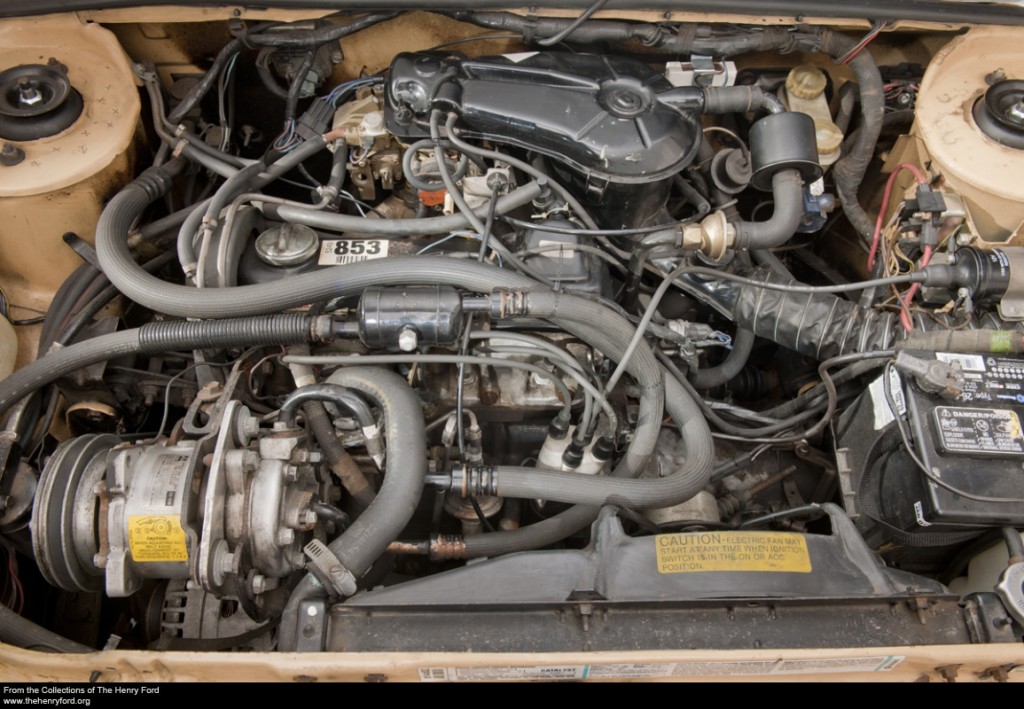Posts Tagged 1970s
Engines Exposed: 1978 Dodge Omni
Inline 4-cylinder engine, overhead valves, 105 cubic inches displacement, 75 horsepower.
Small cars pack a lot into tight spaces. The Omni makes the most of its engine bay by mounting the unit transversely, with the crankshaft parallel to the front bumper. It’s a layout not widely used in American cars since the early 1900s, but particularly well-suited to compact front-wheel drive vehicles. Power is sent to the Omni’s front wheels via the transaxle, a combination gearbox-differential, on the driver’s side.
Matt Anderson is Curator of Transportation at The Henry Ford.
20th century, 1970s, Henry Ford Museum, Engines Exposed, engines, Driving America, cars, by Matt Anderson
Acquiring Our 1976 Apple 1 Computer

When I joined the staff of The Henry Ford, if someone had offered me a glimpse into the future—a bird’s eye view of the events that one short year would bring—it would have taken some time for me to suspend my disbelief. I would have been skeptical if anyone told me I’d play a part in bidding on and acquiring a rare, key, artifact in the history of computing. And if someone told me that this auction would break world records? This is information that I’m still trying to reconcile. Nothing could have prepared me for the anticipation I felt while sitting next to Marilyn Zoidis, former Director of Historical Resources, at Bonhams auctions just a few short weeks ago. I’ll always remember the excitement in the room as we waited for Lot 285 to end—and for Lot 286 to arrive: the 1976 Apple 1 Computer.
On Wednesday, October 22, 2014 The Henry Ford achieved a major acquisition goal. Perhaps you’ve noticed the recent flurry of press: “The Henry Ford Acquires a 1976 Apple 1 Computer at Bonhams History of Science Auction.” Variations on this headline reveal a record-breaking bid amount of $905,000 – but they also hint at the importance, rarity, originality and provenance of this incredible piece of computing history. At the time of this writing, over 1200 news mentions of the Apple 1 have appeared in print, television, radio, and social media outlets.
California, 21st century, 2010s, 20th century, 1970s, technology, computers, by Kristen Gallerneaux, #Behind The Scenes @ The Henry Ford
Just Added to Our Digital Collections: Apple 1
There are only 64 known Apple 1 computers in the world, and only about a quarter of these are operational. One of the latter is now in the collections, both digital and physical, of The Henry Ford. It is not only significant in the early history of one of the most well-known technology companies in the modern world, but also speaks to human-computer interaction, design, and miniaturization of technology. As Curator of Communication & Information Technology Kristen Gallerneaux notes in an upcoming post on our blog: “The acquisition of an Apple 1 represents The Henry Ford’s commitment to documenting the material nature of technology. It is an observable artifact with visual appeal. It has a clear sense of purpose and an honesty expressed through its exposure of internal workings. It could even be considered as a piece of ‘electronic folk art.’” We are very excited to have this incredibly significant artifact in our collections. Visit our collections website to view multiple images of the Apple 1, along with photos documenting its arrival and unpacking at The Henry Ford, or to browse all of our digitized collections relating to computers, and check back soon for Kristen’s blog post to learn more about the history and significance of this artifact.
Ellice Engdahl is Digital Collections & Content Manager at The Henry Ford.
20th century, 1970s, technology, digital collections, computers, by Ellice Engdahl
The Henry Ford has always attracted famous visitors—some of my favorites that are documented in our digital collections include H.G. Wells, Neil Armstrong, and Rosa Parks. But while searching our collections database for something else, I found a name I wasn’t expecting: Lord Mountbatten.
Lord Mountbatten (1900–79) is a fascinating and controversial figure in British and Asian history. The great-grandson of Queen Victoria, he was commissioned as a naval lieutenant in 1920, and held several naval posts during World War II. As supreme allied commander of the Southeast Asia Command, he took Burma from Japanese control, which resulted in an honorary title, Earl Mountbatten of Burma. Continue Reading
travel, 20th century, 1970s, Michigan, Dearborn, Europe, photography, photographs, Henry Ford Museum, Greenfield Village history, Greenfield Village, by Ellice Engdahl





